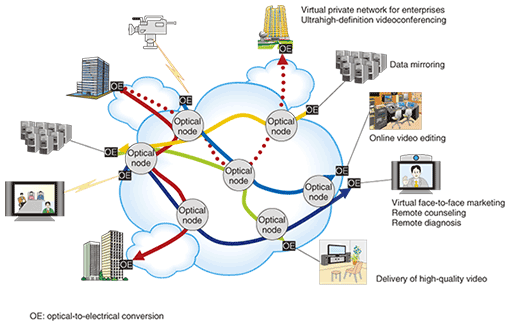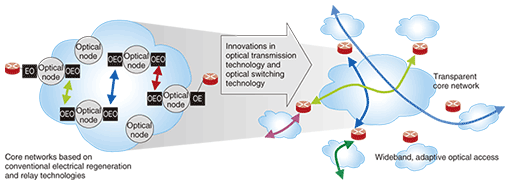 |
|||||||||||||||||||||
|
|
|||||||||||||||||||||
|
Special Feature: Design Concepts for New Generation Carrier Networks Vol. 7, No. 5, pp. 33–40, May 2009. https://doi.org/10.53829/ntr200905sf3 Towards Ultrahigh-speed High-capacity NetworksAbstractThis article introduces technologies that will lead to future photonic networks that support ultrahigh capacities of 100 Gbit/s or more and services with low-latency end-to-end paths (huge-bandwidth services) as a common platform around 2020. Such networks will have on-demand, economical, and highly reliable access and core networks. Technology trends, requirements to be met, and challenges to be overcome are also described.
1. Network requirements in 2020To support the tremendous increase in the amount of Internet traffic, NTT is currently providing a high transmission capacity of 1.6 Tbit/s per optical fiber (40 Gbit/s x 40 wavelengths) on its backbone network. Assuming that traffic will continue to double every two years, the transmission capacity required in about ten years (2020) will be at least 100 Tbit/s equivalent per optical fiber. Although standardization of 100GbE (100-Gbit/s Ethernet) technology and 100-Gbit/s-level optical transport network technology is currently proceeding, we will require higher speeds and capacities in the future. When we consider future networks around 2020, one important issue for the ultrahigh-speed high-capacity network to be used as a common platform is how to economically provide the ultrahigh capacity to support the steady traffic growth rate and the high level of reliability needed for business activities and people°«s daily lives. Moreover, to support continuous traffic growth, it will be essential to achieve low power consumption for the sake of the global environment. From the service provider°«s viewpoint, interactive high-definition video transmission such as that used in business videoconferencing will become increasingly necessary in the future as a service that decreases the load on the environment. The future ultrahigh-speed high-capacity network will not only be a common platform and infrastructure, but will also be expected to act as a service network that can allocate ultrawideband services of this type (huge-bandwidth services). A huge-bandwidth service is defined as one that provides circuit-switched, high-capacity, low-latency, dynamic end-to-end paths. Some examples of assumed services are interactive realtime video communications and data transmission among storage devices (Fig. 1). Business examples are a super-high-presence remote conferencing system, remote medical support system, and storage mirroring and consumer examples are e-commerce based on virtual face-to-face sales, remote counseling, remote diagnosis, remote teaching, and competitive network games. In providing this type of huge-bandwidth service, it will be important to achieve ultralow latency that eliminates all possible delay elements except for distance-dependent transmission delay.
2. Trends in ultrahigh-speed high-capacity networksThe provision of low-power-consuming economical networks that support ultrahigh capacity, high reliability, and extremely low latency will require a combination of the following two points: 1) much higher speeds and capacities from optical fiber transmission and wireless technologies and 2) efficient operation of the network. From the viewpoint of the load on the global environment and economy, we can no longer allow resource consumption to increase at the same rate as capacity; moreover, developments in optical transmission and transfer technologies in recent years [1] mean that we will soon need to cope with the physical limits on optical fiber capacity, which have been treated as infinite up to now. The latter issue is briefly explained below. The first physical limit is optical fiber bandwidth. Core networks, which must transmit signals over long distances, utilize the low-loss wavelength range for optical fibers from 1450 to 1650 nm. This 200-nm bandwidth corresponds to a frequency bandwidth of approximately 25 THz. Based on innovative future technology, if we assume that the frequency usage efficiency can be increased tenfold from the current 0.4 bit/s/Hz and that the entire low-loss wavelength domain can be utilized, then we will only just manage to attain a maximum transmission capacity of 100 Tbit/s per optical fiber. The second physical limit is the optical power that can be input. As the optical fiber data transmission rate increases, we must increase the optical power in the optical fiber. The optical transmission power per unit transmission capacity in the current transmission system is of the order of several tens of milliwatts per terabit per second, so if we apply this straightforwardly to 100-Tbit/s transmission, we get a required transmission power of several watts. This exceeds the threshold (1.5 to 2 W) at which the fiber fuse phenomenon occurs; namely, the optical fiber core melts. Therefore, to support the growth rate of traffic doubling every two years, we must not only fully utilize the potential of optical fiber by developing innovative optical fiber transmission technologies including novel optical fibers that provide even higher speeds and capacities, but must also drastically improve the network resource utilization efficiency though fundamental renovation of the network architecture and operation [2] so that the same network resources can provide multiple network throughputs (Fig. 2).
3. Network architectureAt NTT Research Laboratories, three topics are considered to be important for the architecture of the ultrahigh-speed high-capacity network. (1) Simplification of networks that utilize the potential of optical technology Efforts are underway to simplify networks by introducing higher-capacity routers but using fewer of them and connecting them using high-speed high-capacity optical paths without any intermediate optical-to-electrical-to-optical (OEO) regeneration (Fig. 3).
(2) Adaptive access We are striving to achieve optical and wireless access networks that can be customized to each user and that can flexibly satisfy the wide-ranging bandwidth requirements of each user from a few kilobits per second to over 100 Gbit/s. (3) Efficient usage of network resources We are also promoting efforts to ensure connectivity on a when-needed basis, allocation of just enough bandwidth, flexibility in adjusting the network devices for each service (Fig. 4), and dynamic cooperation between information and communications technology (ICT) resources such as servers and storage and the network resources in order to achieve more efficient networking.
In the next section, we introduce trends in technologies such as optical core network technology, optical access network technology, high-speed wireless access technology, and device technology that form the basis for supporting these future high-speed high-capacity networks. 4. Optical core network technology4.1 Advanced optical transmission technologyTo guarantee the total transmission capacity, which comprises a transmission rate of over 40 Gbit/s per wavelength and a total of over 10 Tbit/s per fiber, we need modulation and multiplexing schemes that occupy a narrow spectral bandwidth. For this purpose, as replacements for the existing optical intensity modulation schemes, the following advanced modulation and multiplexing schemes are good candidates [3].
The optical coherent detection scheme can convert not only optical signal intensity but also phase information into an electrical signal by detecting the beat of the signal light and local oscillator light. This should not only improve the receiver sensitivity but also achieve multilevel and polarized multiplexed signal demodulation that makes full use of digital signal processing technology and various types of transmission distortion equalization. 4.2 Optical transparent networkBesides increasing the per-wavelength bit rate and the total system capacity, an important benefit that the new transmission technologies will bring is expansion of the optical reach, in other words, the distance that an optical signal can travel through multiple dense-wavelength-division-multiplexing (DWDM) links and wavelength cross-connects (WXCs) without OEO regeneration. The narrow bandwidth properties of the modulation and multiplexing technique are favorable not only for enhancing the transmission performance and spectral efficiency but also for reducing the filtering effect caused by passing through multiple WXCs, which will considerably expand the optical transparent domain. These new transmission technologies will open up new perspectives for the design of backbone transport networks, changing optical transport networks from opaque to transparent. In transparent optical transport networks, time-consuming manual installation of OEO equipment and link-by-link adjustment of optical compensation devices will no longer be required at intermediate sites. This will substantially reduce the system cost, power consumption, footprint, and operating costs. Since an optical signal can be copied through simple optical power splitting, optical signals can be distributed economically with low energy consumption by optical multicasting. Technology such as generalized multiprotocol label switching (GMPLS), which is a standard technique introduced in the control plane, can be used to control this type of optical network dynamically. Furthermore, dynamic cooperation between ICT resources (such as servers and storage) and network resources should lead to virtualized and effective use of all ICT resources [4]. 4.3 Elastic optical pathIt was initially assumed that huge-bandwidth services would be provided using an optimal combination of optical cross connects and electrical time division multiplexing (TDM) cross connects. That is, users requiring ultrahigh-capacity paths would be provided with fixed-bandwidth optical paths, e.g., 100 Gbit/s. For users requiring smaller paths, e.g., 10 Gbit/s, we would groom the electrical paths within the optical path by using electrical TDM cross connects. In this way, we could aim to increase the usage efficiency of the network. At NTT Research Laboratories, as the next step, we are engaged in research on elastic optical path networks [5] in which we can freely adjust the optical path capacity (Fig. 4(a)). In an elastic optical path network, the capacity of the optical path is not fixed: instead, it is expanded or contracted according to user request. A transmitter generates an optical signal with spectrum of the right size to accommodate the user traffic. Accordingly, every optical node on the route of the optical path allocates a cross-connection with appropriate spectrum bandwidth. When the user traffic increases, the transmitter increases the line capacity, and every optical node on the route expands the switching window, which enables the establishment of an elastic optical path. In this way, elastic optical path networks achieve fine granularity in switching capability in the optical domain, and we can expect still lower power consumption, space conservation, and economization. 5. Access network technology5.1 Optical access network technologyThe considerable increase in the volume of communications traffic that has accompanied the current rapid diffusion of fiber to the home (FTTH) will accelerate the increase in demand for high-speed broadband service. The diffusion of FTTH will invite further variety and diversity in user demands; for example, the bandwidth used by each user will expand to encompass a minimum of several kilobits per second and a maximum of more than 100 Gbit/s. Furthermore, with the recent emphasis on environmental awareness, making communication systems that consume less power has become increasingly important. In particular, making the entire network, which comprises access networks constructed from tens of millions of optical network units (ONUs) and several million optical line terminals (OLTs), energy efficient is an important research theme. Future access network construction is an important investigation item on the path toward achieving higher speeds, wider bandwidths, and bandwidth with a wide dynamic range while suppressing increases in power consumption. At NTT Research Laboratories, we are striving to establish basic technologies that will address these research themes. In the past, ultrahigh-speed and broadband technologies for networks were dependent on performance improvements in electrical devices. However, several years ago we came to realize that we were approaching the limit of the electrical device performance of this key technology and that we needed network construction technology that does not depend heavily on device performance. We are investigating ways to achieve even higher network speeds and wider bandwidths based on multi-wavelength parallel transmission technology, which can elicit maximum performance from both the electrical and optical devices. On the other hand, to handle the increase in the range of bandwidths wanted by users as their needs diversify, we are investigating the network°«s utilization efficiency and power consumption in accommodating the current maximum utilized bandwidth. For this purpose, we propose the concepts of an adaptive access network (AAN) and a network on demand (NoD) instead of the previous static network, where the network is dynamically customized to each user according to that user°«s usage style. We are now investigating technologies for realizing these concepts. In regard to energy conservation in the system, which is in conflict with the aims of achieving higher speeds and wider bandwidths, we are investigating technologies to expand the service area of the optical access system using optical characteristics such as low-loss and wideband transmission, along with the abovementioned AAN and NoD concepts. Among these is a technology for achieving improvements in the accommodation efficiency that is based on the elastic OLT (E-OLT) technology, in which network accommodation equipment for each service is changed in a virtual manner (Fig. 4(b)). NTT Research Laboratories has proposed an all-optical network in which wavelength-based access systems and core systems cooperate, and it is conducting research to achieve technology that will provide an entire network with ultrahigh speed, wider bandwidth, lower latency, and lower power consumption. We expect this technology for making an end-to-end all-optical network, which will carry several-hundred-gigabit-per-second-class data with low latency, to lead to innovative services that have not been seen before. 5.2 Terabit LAN technologyWe are pursuing the research and development (R&D) of technology for a terabit LAN [6], which is a virtual local area network (LAN) constructed on an all-optical network. It will provide a multiwavelength interface with 10 to 100 Gbit/s per wavelength that can be freely divided among multiple destinations. Our investigation targets include parallel transmission technology with various levels of parallelism and transport protocols suited to huge-bandwidth services with extremely low latency. We expect that terabit LAN technology will be used in future networks like Ethernet LAN technology is used in current optical access networks. 5.3 Ultrahigh-speed wireless access technologyR&D is being conducted on ultrahigh-speed wireless access technology to provide transmission speeds from 1 Gbit/s to over 10 Gbit/s utilizing the millimeter-wave band (60- and 120-GHz bands). In the 60-GHz band, we are creating wireless system technology that exceeds 10 Gbit/s on the basis of four-channel multiplexing of about a 2-GHz band per channel. Moreover, we are conducting R&D on antenna-integrated millimeter-wave system-in-package technology [7], which achieves compactness, high speed, and mobility at the same time. This technology should lead to a 1-cm3-class battery-driven ultrahigh-speed wireless communication device. Furthermore, in the 120-GHz band, we are collaborating with broadcasting companies in research on ultrahigh-speed devices based on InP high electron mobility transistors for use in outdoor transmission wireless systems that can handle broadcast transmission (uncompressed high-definition images) [8]. Based on optimization of technology currently under development and further multi-levelization, we expect wireless super-high-vision (24 Gbit/s) transmission to be achieved. 6. Device technology6.1 Optoelectronic device technologyTo achieve ultrahigh-capacity transmission, we must increase the bit rate per wavelength and develop devices for 100-Gbit/s transmission. In particular, because dispersion tolerance and receiver sensitivity must be increased, we plan to develop a key component of a coherent transceiver, for which digital signal processing is a prerequisite. Furthermore, we are striving to develop technologies such as planar lightwave circuit (PLC) technology and microelectromechanical systems (MEMS) technology, and we are promoting R&D for devices with new optical functions that will become the core of the optical transparent network. With the aims of achieving drastically lower power consumption in the network and studying the possibility of optical packet switching, we are aggressively conducting R&D of optoelectronic-aggregate-type optical packet router component technology. 6.2 Optical fiber technologyAs optical fiber technology [9] that will support future networks, we are conducting R&D of highly bendable optical fiber in which the bending loss is greatly reduced by introducing a holey structure (hole-assisted optical fiber). This will probably lead to renovation of the entire optical cable system including the introduction of ultrathin cables and reforms in closure design. Furthermore, based on advancements in the photonic crystal structure, we are striving to make optical fiber that can carry ultrawideband, high-power optical signals. We expect these technologies to have a significant impact on efforts to make an optical transparent network. 7. Future developmentFinally, we present some of our future targets.
NTT Research Laboratories will continue to collaborate with domestic and international research institutions while endeavoring to produce innovative ultrahigh-speed high-capacity network technologies that will support future networks in 2020. References
|
|||||||||||||||||||||


















